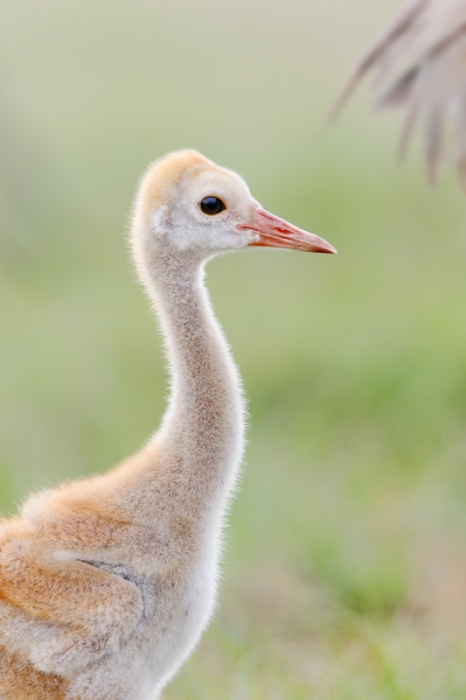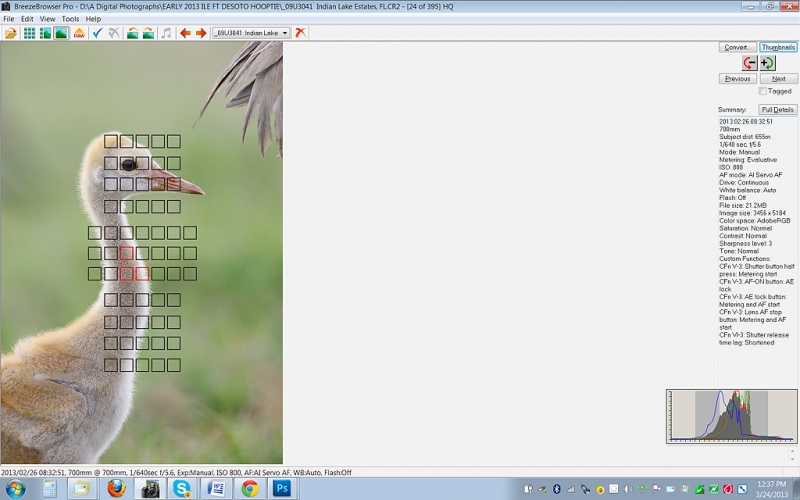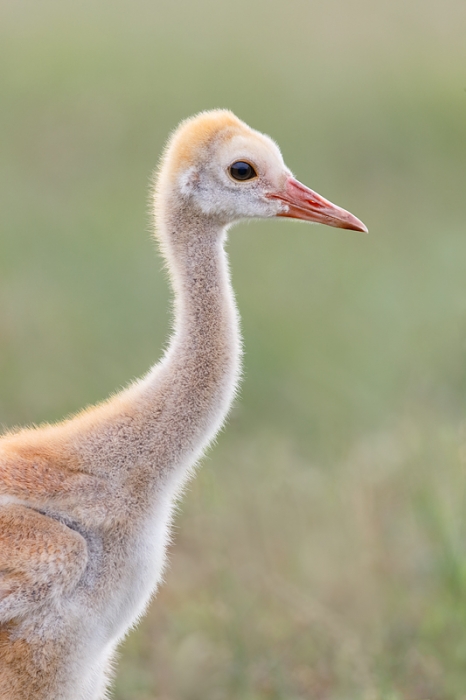|
This image was created at Indian Lake Estates on the morning that the IPT group made the early trip from Fort Desoto to my home. I used the hand held Canon 500mm f/4L EF IS II lens, the Canon 1.4x EF tele-extender III, and the Canon EOS-1D X. ISO 800. Evaluative metering +1 stop as framed in soft light: 1/640 sec. at f/5.6 in Manual mode confirmed in advance via histogram check. IS Mode 1. Left knee as tripod. 61-Point/AI Servo/Rear Focus AF active at the moment of exposure performed perfectly. Click here if you missed the Rear Focus Tutorial. Click on the image for a larger version. Learn everything that I know about the great AF system of the 1D X in our 1D X AF Guide here. Learn how and why I am converting all of my images in Canon DPP (Digital Photo Professional) in our DPP RAW Conversion Guide here. |
The Image Optimization
In the image above, the rear end of the adult standing nearby appears in the upper right corner. As you can see by looking at the BreezeBrowser Screen capture below, the adult’s rear end was fairly sharp in the original capture. To soften it I painted a Quick Mask of the rear end, put it on its own layer (Control J), and applied a 30 pixel Gaussian Blur. Other than that just the usual 50/50 NIK Color Efex Pro stuff (Tonal Contrast and Detail Extractor) at 25% opacity, a tiny bit of Eye Doctor work, and sharpening of the face and upper neck with a 15/65/) Contrast Mask.
All of the above as detailed in Digital Basics that includes my complete digital workflow, all of my time-saving Keyboard Shortcuts, Quick Masking, Layer Masking, and NIK Color Efex Pro basics, and dozens of great Photoshop tips.
61-Point AF
Above is the BreezeBrowser Main View screen capture for the opening image. The illuminated red squares on the bird’s neck indicates that AF sensors that were active at the moment of exposure. Make sure to check Show Focus Points under View to activate this feature. To see the focus points in DPP check AF Point under View or hit Alt L.
Note also the sharpness of the adult’s rear end.
Only when using 61-Point AF will more than a single AF point be illuminated. The trick with 61-point is to know exactly when to use it. There have been lots of great examples of when in various blog posts over the past six months. For the whole story in a neat package see our 1D X AF Guide or the 5D Mark III User’s Guide. All of my 1D X and 5D Mark III images are converted in Canon’s Digital Photo Professional. See our DPP RAW Conversion Guide to learn why and how.
Regular readers know that I use and depend on BreezeBrowser every day of the year. It allows me to sort my keepers and deletes the rejects faster than any other browsing program. We use it on the main computer in the home office to catalog our images file-drawer style. And the companion program, Downloader Pro allows me to download my images quickly and conveniently. It automatically adds my IPTC data and the shooting location. I have it set up to create a folder named by the Month/date/year. The Breezebrowser/Downloader Pro combo saves me many hours each week. To learn earn more or to purchase this great PC only program, click here.
|
This image was also created at Indian Lake Estates on the morning that the IPT group made the early trip from Fort Desoto to my home, just moments after the opening image in this blog post. Again I used the hand held Canon 500mm f/4L EF IS II lens, the Canon 1.4x EF tele-extender III, and the Canon EOS-1D X. ISO 800. Evaluative metering +1 stop as framed in soft light: 1/640 sec. at f/5.6 in Manual mode confirmed in advance via histogram check. IS Mode 1. Left knee as tripod. 61-Point/AI Servo/Rear Focus AF active at the moment of exposure performed perfectly. Click here if you missed the Rear Focus Tutorial. Click on the image for a larger version. Learn everything that I know about the great AF system of the 1D X in our 1D X AF Guide here. Learn how and why I am converting all of my images in Canon DPP (Digital Photo Professional) in our DPP RAW Conversion Guide here. |
Like the Rear End or Not?
Take a moment to leave a comment and let us know which image you like best and why. If there is something additional that you like about one image or the other, be sure to let us know that too. I am assuming that nobody prefers the original capture with the sharp rear end but if you do feel free to chime in.
|
Images courtesy of and copyright 2012: Bill Mueller. Card design by Denise Ippolito. |
Old Car City Creative Photography In-the-Field HDR Workshop: Sunday, October 13, 2013/ 9am till 1pm.
White, Georgia: $250 plus a $15 entrance fee donation (cash only on the day of the event) that will go to charity. Limit: 16 photographers.
On October 13, 2013, Arthur Morris/BIRDS AS ART and Denise Ippolito/A Creative Adventure will be conducting an In-the-Field HDR Workshop at Old Car City in White, Georgia. Old Car City is about an hour north of Atlanta, GA and an hour south of Chattanooga, TN where they will, as noted above, be doing a full day seminar for the Photographic Society of Chattanooga on Saturday, October 12th. Click here for complete details.
Fort Desoto/Hooptie Deux–Roseate Spoonbill Short Notice IPT
The 2nd New Concept IPT: the Fort Desoto/Hooptie Deux–Roseate Spoonbill Short Notice IPT/April 3-7, 2013/5 DAYS: $2399. Strict limit: six photographers/ openings 5. Early April can be superb at Alafia Banks. Early April is almost always superb at Fort DeSoto. Click here for complete details.
With only a single registrant, this one is shaping up to be a practically private affair and represents an amazing opportunity for you to grow as a photographer.
Typos
On all blog posts, feel free to e-mail or leave a comment regarding any typos, wrong words, misspellings, omissions, or grammatical errors. Just be right. 🙂
Support the BAA Blog. Support the BAA Bulletins: Shop B&H here!
We want and need to keep providing you with the latest free information, photography and Photoshop lessons, and all manner of related information. Show your appreciation by making your purchases immediately after clicking on any of our B&H or Amazon Affiliate links in this blog post. Remember, B&H ain’t just photography!


















After thinking about this for a while, I definitely prefer the version with the blurred adult rear end. The sharp one distracts me from the juvenile. I think the blurred one adds interest without pulling my eye away from the main subject – a cute, fluffy, baby crane.
I like the one with the blurred tail. But I don’t know why? Maybe the subtle context or some kind of subliminal vignette effect that it gives.
I prefer the blurred version – seems like a natural vignette to me.
Question: Have you noticed the AF being slower in 61 point mode than single focus point with surrounding helper points mode?
Exactly what do you mean by slower?
slower to acquire focus? My 1D4s are slow to acquirre focus when all focus points are active compared to having only one focus point active.
I rarely use the ring of fire with the 1D IV. Do you have a 1D X? IAC, I agree that when you have all the sensors active that initial focus acquisition is slower than with any other pattern or with the central sensor in any form. But in the right situation it is the best option…. As it was here.
I never use the ring of ire in the 1D4 because it is too slow to acquire focus. The 5D3 seems a bit faster but I have not purchased a 1Dx to try for myself.
There are times when ring of fire is clearly best. I believe that they are detailed in the MIV User’s Guide. Another trick with that camera and ring of fire is to acquire focus on the edge of the array (despite what Canon advises….) artie
Prefer no rear end. Blurred rear end is distracting and has no meaning since it is unclear (pun intended) as to what it is. Sharp rear end adds some meaning but is distracting too.
Art, I vote with those that prefer the sharp rear end or no rear end. I think having the sharp rear provides the feeling of a protective parent close by. I think the blurred rear is distracting because the viewer may not be sure as to exactly what it is. It could be some sort of foliage from a nearby plant.
Would vote for the sharp too. Believe it adds some proportion and interest. Really nice either way though.
Lovely colt! I prefer either a sharp rear or no rear…
I think I might actually like the sharp rear end. With it being sharp, it seems like the chick is closer to the adult, has some connection to the adult (mother?) and that the rear end was purposely placed in the composition. But really, I love any good image of a sandhill crane chick!
I actually like the sharp rear. For me at least, with
it sharp I get more of a sense of the little one being
protected by it following close and with the feathers
above.
This is quite ironic. I made a nearly identical image this morning at Circle B. I’ve only offloaded the images from my card but this image, and the debate to keep the rear-end of the adult or not, stood out. I think I like the rear as it adds to the story. It doesn’t show much but it tells the story of the little one following close to mom/dad.